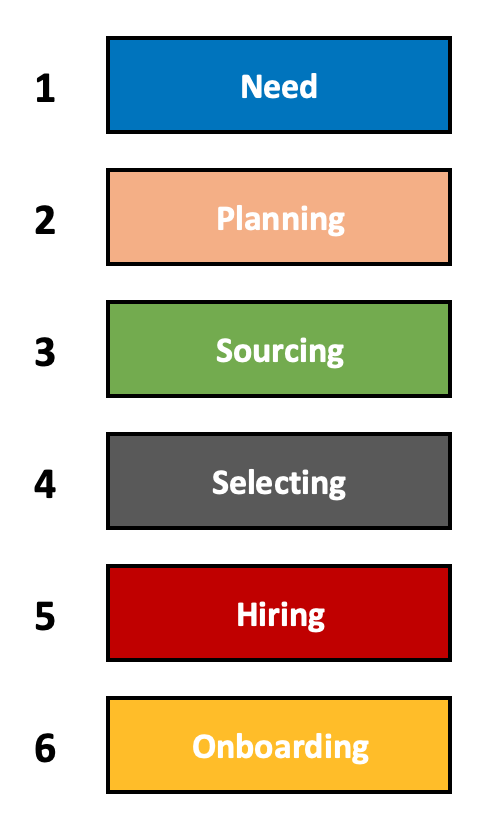
Finding excellent talent and employing them in the organization is a crucial enabler for any successful enterprise. This is normally facilitated by:
- Recruitment, which is a broad range of activities with various stages, from identifying a need to onboarding new staff.
- Selection, which is a more narrow task dealing with the selection of a potential employee from a pool of candidates.
This article explores the meanings behind Recruitment vs. Selection; we’ll be covering:
- Recruitment vs. Selection
- What is Recruitment
- What is Selection
- Key differences between Recruitment vs. Selection
Recruitment vs. Selection
CIPD (the Chartered Institute for Personnel Development) defines the typical stages of the recruitment process as:
- Defining the role
- Attracting applicants
- Administering the selection process
- Making an appointment
From this, we can see that employing people requires various processes, disciplines, and skills.
To understand recruitment and selection, it helps to view respective inputs, activities, and outputs.
| Recruitment | Selection | |
| Inputs | Resource needs + requirements | Group of potential candidates |
| Activities | Identifying, Attracting, Selecting, Hiring, Onboarding | Shortlisting & Evaluating applicants (evaluation may include interviewing, psychometric tests, etc.) |
| Outputs | Candidates obtained for interview, onboarding | Finding the most suitable candidate, rejecting the remainder. |
The result of these processes must ensure that the organization is armed with the right talent, skills, and experience by finding the right individuals (for the right roles) at the right time.
As you can see, there are key differences between the two sets of activities.
Let’s look at both elements:
What is recruitment
The recruitment process is traditionally administered through a Human Resources function. It can be executed within the organization or via the use of 3rd party specialist companies.
The recruitment process is a series of steps
The recruitment process usually includes the following steps:

- Identification of need
- Planning (requirements, targeting etc)
- Sourcing potential candidates
- Selecting the candidate
- Hiring – Making Offer of Employment
- Onboarding

Recruitment can resource needs through two methods:
1/ External recruitment – recruiting new people from outside the organization.
2/ Internal recruitment – recruiting from an existing pool of talent within the company.
Many see recruitment & selection as two distinct and different steps and part of a wider “employment process“:
- Recruitment: attracting potential candidates
- Selecting: Identifying the most appropriate candidate.
What is Selection
Selection targets the identification of the most appropriate prospective employee from a group of applicants.
An effective selection process should identify the right person for the job, ensuring that they are:
- Eligible
- Have appropriate qualifications
- Have appropriate experience
- Have appropriate skills & competencies
- Have appropriate soft skills that will enable the individual to work well within the organization.
Selection usually includes several stages and various activities, which include:
- Screening
- Eliminating unsuitable candidates
- Conducting an examination (aptitude test, intelligence test, performance test, personality test, etc.)
- Interviews
- Checking references
- Medical tests
Depending on the complexity of the role/requirement, selection can take some time to complete.
Key differences between Recruitment vs. Selection?
There are several key differences between recruitment and selection; including:

Range of Activity
Recruitment is a broad range of activities that deal with requirements definition through to onboarding new staff and typically includes selection.
The selection process focuses on a key set of activities, including assessing a range of candidates, selecting an appropriate candidate, rejecting those not suitable.
Quantity vs. Quality focus
Selection focuses on the down selection (scrutiny and assessment) and the final candidate’s quality, identifying the ‘best and most suitable.’
In contrast, the earlier stages of recruitment focus on quantity obtaining numbers or a pool of candidates that meet high-level requirements.
Risk
It can be argued that poor selection poses the most risk to an organization from within its recruitment process (the result would be to bring in inappropriate employees into the business).
Skills
The wider recruitment process is likely to involve a more broad skill set, defining requirements, advertising roles, onboarding, etc.
The selection process has a more narrow skillset that of sifting, analyzing, decision making.
Levels of responsibility
While relatively junior members of staff can undertake certain activities within the early stages of recruitment (such as resource needs, advertising, etc.), the selection process (perhaps due to the impact if it goes wrong) is usually administered by more senior staff.
Summary
The recruitment process is complex and of key importance to a business.
The recruitment process has various stages.
It can be argued the recruitment involves the identification of need through to onboarding new staff.
Selection involves a specific stage of recruitment, selecting the most suitable candidates from a range previously identified.
I hope you found this article useful. We love to hear feedback, you can reach us at @sanbustrain on Twitter, or you can use the comments section below.
This article is part of our Human Resources Guide.